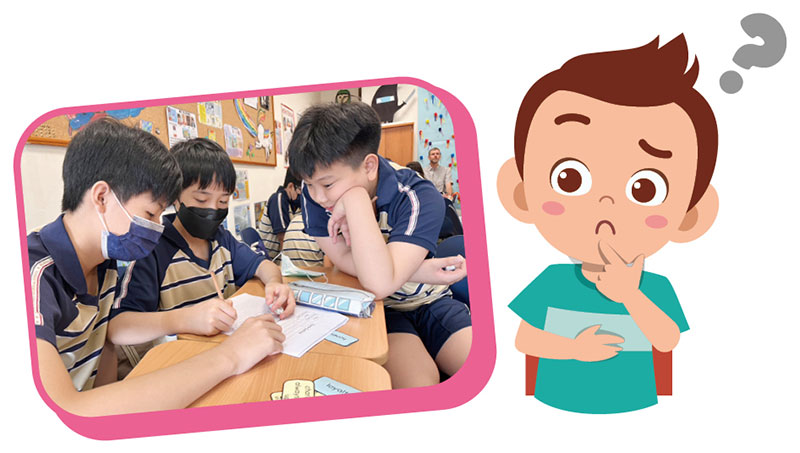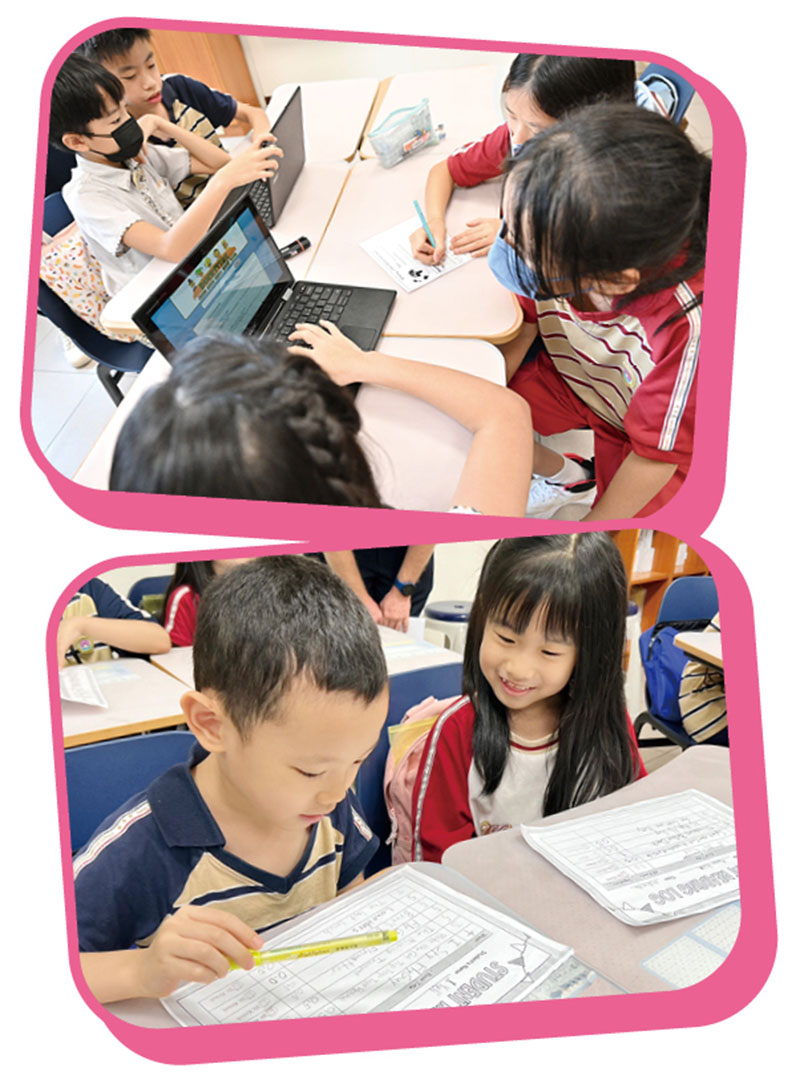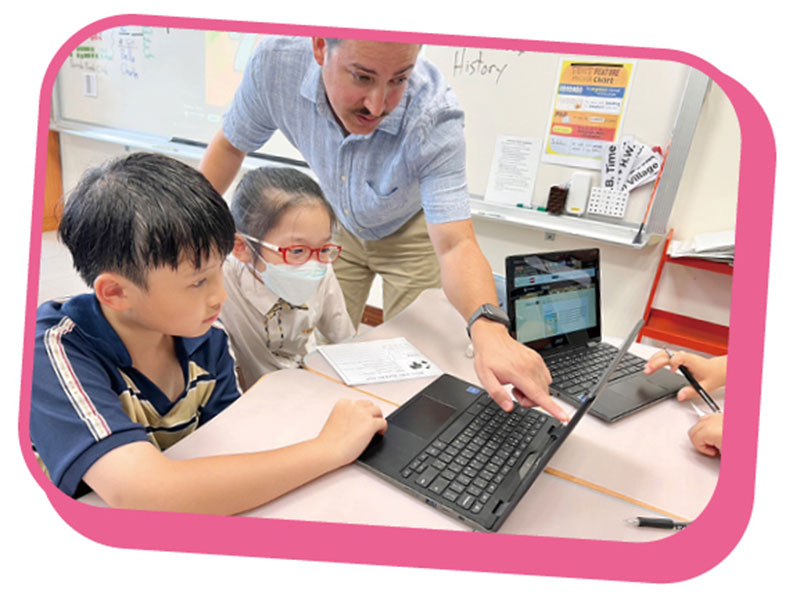

~ Zachary Warmke
Curriculum Coordinator

Last year, we implemented an all-new English curriculum in foreign English teachers’ classes. We changed all of the texts we read and discuss in class. Furthermore, we changed our approach to using English in the classroom. Group discussions have always been an important part of our lessons. But now, using our new curriculum, we have made discussion and critical thinking a core part of students’ learning process.
Using English for Meaningful Communication
The English program at Kang Chiao is designed to be immersive. We want students to think in English, and not just translate from their native language. This means that we use all four language skills – reading, writing, listening, and speaking. Class discussion is a great way to use all four skills at once in a way that is fun and motivating to students.
You may have noticed pages in our textbooks that contain “Turn and Talk” sections. When we read these pages in class, students break into small groups to discuss and write with peers. Teachers do not grade these discussions, so students feel encouraged to speak to others without the pressure of losing points.
Projects are also a great time for students to have discussions. All projects require teamwork and collaboration. Students must plan their work in groups while speaking English. In the research stage, they conduct surveys, read books and articles, or conduct interviews. While writing, students may work with a partner to proofread their rough drafts. Finally, students practice presenting to their trusted friends before they present to the whole class. These are all great chances for students to help each other through discussion.
Our current project in grade 1, I’m Hooked on Books, is a good example. Students read library books independently during Hooked on Books time, then they share and suggest their favorite ones with their friends. So not only do they read English books, they talk about them with others in English. This sets a high standard for our students. They do not only have to write a book review in their second language. They have to read and discuss several books, have conversations about their likes and dislikes, and suggest books to others. That requires a very high degree of English skill.

Incorporating Effective Discussions in English Class

Students’ ability to have meaningful in-class discussions shows their high level of English skill. We set high standards for communication. We don’t just want students to repeat information about a topic they have memorized. We want them to teach their classmates about the topic, or explain their thoughts and opinions about it. If they can do that, we know they understand the topic on a deep level, and we know their English ability is high. However, it can take time for students to become comfortable with discussing things with their classmates in their second language.
Teachers use simple models to help students stay on track during class. We use phrases like “discuss, agree, do,” or “think, pair, share.” Whenever a hard question comes up in class, the teacher will prompt students to follow this model.
My View, My Perspective
Whether students are working on projects, readings, or other work, they benefit from guided discussions. They speak English in class to talk about their own experiences, consider what they would do in different situations, or make connections among many different topics. By sharing with peers, students practice communicating and learning from one another.
The result of all this collaboration is our wonderful community of eager, accomplished learners. They develop their perspectives on a variety of subjects without relying on their first language. They think in English, like native speakers do. Our classrooms become communities of helpful students who share and work together, all while communicating in their second language.
From the Editor
Think, Discuss and Learn
國際處主任 賴國宜
With the introduction of educational concepts such as "flipped learning" and "learning community", more and more people are recognizing that learning through discussion is more effective than one-way knowledge transmission by teachers. However, how to conduct discussions, what to discuss and how to prevent students from veering into casual conversation all require careful planning by teachers. In our English classrooms, discussions play a significant role. They are not only engaging and highly interactive, but also essential for students in developing their critical thinking skills and enhancing their proficiency in English expression. In this edition, Mr. Warmke explains how teachers use discussions to facilitate a deeper understanding of the reading and to encourage exploration of projects. Through the process, students are no longer merely limited to seeking a single standard answer but are challenged to read more comprehensively and think more deeply.
隨著「翻轉學習」、「學習共同體」等教學理念的引入,越來越多人認同討論方式的學習比教師單向傳授知識更能促進有效學習,然而,如何進行討論,討論什麼,而不會流於抒發個人意見的閒聊,都需要經過教師在備課時精心設計。在康橋的英語課堂中,討論佔據了重要的地位,這不僅因為它是有趣且互動性強的學習方式,更因為討論可以幫助孩子培養思考能力和提升英語表達能力。本期,我們透過課研組長Mr. Warmke的文章,帶您更深入了解老師們如何在各種課堂上透過討論,幫助孩子深入理解課文或探究主題,在互相辯證的過程中,孩子們不再只追求唯一的標準答案,而是受到挑戰,想讀得更深入,思考得更透徹。
康橋校園就像個大寶藏,除了教室以外,處處藏著孩子們下課最愛去的秘密基地,二年級剛剛完成了Kang Chiao Treasures專題,要跟小一學弟妹分享他們最喜愛的校園角落。除了文字的介紹,他們還實地拍攝了影片,歡迎您欣賞他們的文章並掃描QR code觀賞影片,下次有機會進校園時,別忘了參觀這些孩子們強烈推薦的康橋寶地。